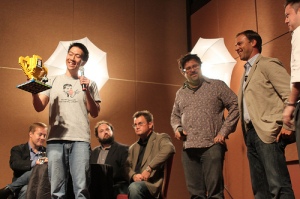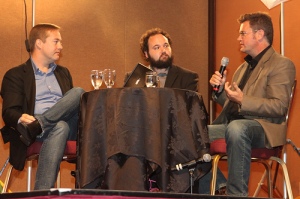 I run a monthly meeting called the VCA that represents the majority of Southern California venture capital firms. My goal is to bring in informative speakers who stretch our collectively thinking on topics that will influence our investment strategies and use it as a way for us to share our experiences in ways that I hope benefit the Southern California technology ecosystem.
I run a monthly meeting called the VCA that represents the majority of Southern California venture capital firms. My goal is to bring in informative speakers who stretch our collectively thinking on topics that will influence our investment strategies and use it as a way for us to share our experiences in ways that I hope benefit the Southern California technology ecosystem.
In the past 6 months we’ve heard from Dmitry Shapiro on the future of online video, Ian Rogers on the future music model, David Sacks on the future of social networking and Michael Crandell on where Cloud Computing is headed.
All have been fascinating. This month’s presentation was truly mind boggling so I wanted to be sure to share the entire presentation with all of you. This was one of the most fascinating presentations I’ve seen in a long time and a must read – although you’ll see clearly better in person with commentary. Benjamin Joffe (the author), a Frenchman who runs a consultancy in China that tries to help non-Asian investors understand the innovation occurring in Asia as a way to bring ideas to their local markets. He also consults companies in Asia.
I lived in Europe for 11 years and in Tokyo for 6 months so the idea that innovation is happening outside of our 50 states in not new to me. I’m sometimes surprised how little people here in the US want to try to learn from what is happening elsewhere. I find that a shame. When I reached out to Benjamin at the suggestion of Dave McClure who told me what a great guy he was I was fascinated.
To see the deck click —-> HERE (sorry, I can’t do embeds yet, I’m migrating from WordPress.com to WordPress.org in the next few weeks). As I mentioned, some pages unintelligible without commentary but well worth a read to get to the nuggets.
My take aways are below:
1. Wacky, weird and low cost: Before diving into what I learned in the deck I want to share something crazy. Motorola gave us in the US the RAZR (before they stopped innovating). But China literally gave us the Cell Razor. Benjamin brought in a cell phone where the bottom pulls out and you have an electric razor. No joke.
2. Film innovation – If Benjamin’s analysis is right – even many of our most successful films have been adaptations from Asian films. I knew some were but the scope was surprising. Especially Star Wars & The Matrix.
3. Internet users in US – 225 million, mobile 260MM. China Internet: 340MM, Mobile a staggering 650MM. Don’t bet that China won’t innovate in mobile. (slide 29)
 4. 70% of Korean population has Internet speeds > 5mbps (and avg = 15 mbps) – don’t bet that the Koreans won’t innovate on online content (slide 30). Larger online game market ($1 billion) than Japan despite 1/3 population and 1/2 GDP per capital (slide 99). Way ahead of the US on mobile gifting.
4. 70% of Korean population has Internet speeds > 5mbps (and avg = 15 mbps) – don’t bet that the Koreans won’t innovate on online content (slide 30). Larger online game market ($1 billion) than Japan despite 1/3 population and 1/2 GDP per capital (slide 99). Way ahead of the US on mobile gifting.
 5. More than 90% of Japanese mobile subscribers are on 3G networks (vs. 20% in the US) (slide 30), More than 50% have mobile TV & NFC chipsets (slide 87). Mobile ARPU = a staggering $110 / month for content and commerce alone (slide 88). Massive fall-off in ringtone and massive uptick in full songs (slide 89) —> still think we shouldn’t be watching what’s happening in Asia? Sales of avatars in social games nearly 50% of total revenue eclipsing revenue from affiliate transaction, ads or paid games (slide 97). Mobile game content revenue > PC game revenue (slide 98)
5. More than 90% of Japanese mobile subscribers are on 3G networks (vs. 20% in the US) (slide 30), More than 50% have mobile TV & NFC chipsets (slide 87). Mobile ARPU = a staggering $110 / month for content and commerce alone (slide 88). Massive fall-off in ringtone and massive uptick in full songs (slide 89) —> still think we shouldn’t be watching what’s happening in Asia? Sales of avatars in social games nearly 50% of total revenue eclipsing revenue from affiliate transaction, ads or paid games (slide 97). Mobile game content revenue > PC game revenue (slide 98)
6. China’s leading social network (Tencent, who’s product is QQ) already does more than $1 billion in revenue. That’s 2x Facebook estimates. Tencent market cap on public market is $21 billion, Facebook’s is a theoretical $3-15bn (slide 52). China is innovating in many of the categories that the US is trying to solve now including mobile

couponing, vertical social networks, Internet TV, etc.
7. Free-to-play gaming with micro transactions has become huge in Asia with very nice profit margins. EA and others in the US are copying this success (slide 71)
When I lived in Europe in the 90’s we all texted people on mobile phones. I was surprised when I came back to the US and the only people texting were 13 year olds. When I worked in Japan it was crazy how much people were using mobile content on the i-mode phones. Now they have TV & NFC chips. I have been looking at a South Korean online start-up and am blown away by the innovation in this company relative to the online models I see in the US. It is a global world – I plan to make sure I’m tapped into Europe, Israel and increasingly Asia to know what trends I can look for here in California.



 Posted by Mark Suster
Posted by Mark Suster 


 The late night didn’t make for a productive start to the morning but by the time Sean Percival got on stage to host the panel with Chris Brogan, Micah Baldwin (who started #FollowFriday) and Ben Huh (ICanHazCheeseburger) there was a great discussion on what it takes to be an Uber-blogger and social networker. I think I could summarize the hour by saying, “don’t be a douche.” And we heard Sean’s rant of the moment about how he hates being shaken down for DM’s by friends asking for RT’s and how he’s tired of DM Spam in general.
The late night didn’t make for a productive start to the morning but by the time Sean Percival got on stage to host the panel with Chris Brogan, Micah Baldwin (who started #FollowFriday) and Ben Huh (ICanHazCheeseburger) there was a great discussion on what it takes to be an Uber-blogger and social networker. I think I could summarize the hour by saying, “don’t be a douche.” And we heard Sean’s rant of the moment about how he hates being shaken down for DM’s by friends asking for RT’s and how he’s tired of DM Spam in general. as one of the worst deals in history”) to the skewering Jason gave to his competitor Nick Denton (of Gawker fame) when he stole his most productive employee.
as one of the worst deals in history”) to the skewering Jason gave to his competitor Nick Denton (of Gawker fame) when he stole his most productive employee. leaders present to the best VC’s in Southern California so that we can better understand the trends and develop tighter relationships with our local technology leaders. In recent sessions we have had
leaders present to the best VC’s in Southern California so that we can better understand the trends and develop tighter relationships with our local technology leaders. In recent sessions we have had 
